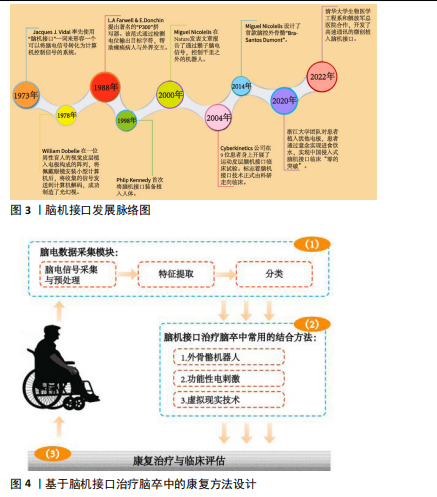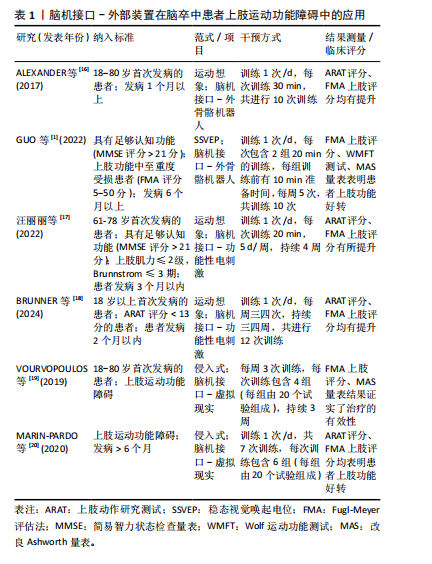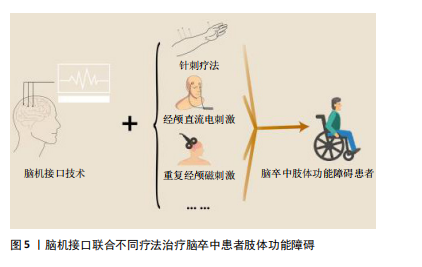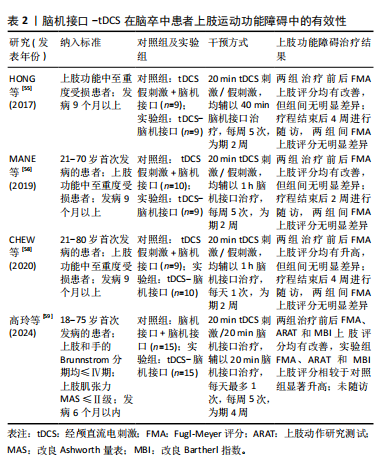[1] GUO N, WANG X, DUANMU D, et al. SSVEP-Based Brain Computer Interface Controlled Soft Robotic Glove for Post-Stroke Hand Function Rehabilitation. IEEE Trans Neural Syst Rehabil Eng. 2022;30:1737-1744.
[2] CAI S, ZHOU Y, YANG S, et al. The neural effects of acupuncture for stroke: a protocol for systematic review and meta-analysis based on fMRI. Front Neurosci. 2024;18:1443834.
[3] LEBEDEV MA, NICOLELIS MA. Brain-Machine Interfaces: From Basic Science to Neuroprostheses and Neurorehabilitation. Physiol Rev. 2017;97(2):767-837.
[4] WOLPAW JR, BIRBAUMER N, HEETDERKS WJ, et al. Brain-computer interface technology: a review of the first international meeting. IEEE Trans Rehabil Eng. 2000;8(2):164-173.
[5] FARWELL LA, DONCHIN E. Talking off the top of your head: toward a mental prosthesis utilizing event-related brain potentials. Electroencephalogr Clin Neurophysiol. 1988;70(6):510-523.
[6] PFURTSCHELLER G. Event-related synchronization (ERS): an electrophysiological correlate of cortical areas at rest. Electroencephalogr Clin Neurophysiol. 1992;83(1):62-69.
[7] MIDDENDORF M, MCMILLAN G, CALHOUN G, et al. Brain-computer interfaces based on the steady-state visual-evoked response. IEEE Trans Rehabil Eng. 2000;8(2):21121-21124.
[8] 丁晶,余情,唐莺莹,等.基于头皮脑电信号的无创脑机接口在神经系统疾病中的临床应用上海专家共识[J].上海医学,2024,47(4): 199-213.
[9] 袁艳秋,张秀芳,陈杰,等.经颅电刺激技术联合脑机接口技术对脑卒中患者认知功能及上肢功能的影响[J].实用心脑肺血管病杂志,2024,32(4):71-75+79.
[10] MASLOVA O, KOMAROVA Y, SHUSHARINA N, et al. Non-invasive EEG-based BCI spellers from the beginning to today: a mini-review. Front Hum Neurosci. 2023;17:1216648.
[11] PICHIORRI F, MATTIA D. Brain-computer interfaces in neurologic rehabilitation practice. Handb Clin Neurol. 2020;168:101-116.
[12] KHAN MA, DAS R, IVERSEN HK, et al. Review on motor imagery based BCI systems for upper limb post-stroke neurorehabilitation: From designing to application. Comput Biol Med. 2020;123:103843.
[13] 杨帮华.运动想象脑机接口在神经系统疾病康复中的应用[J].康复学报, 2023,33(6):477-485.
[14] 杨帮华,马骏,邱文政.面向脑卒中疾病的运动想象脑机接口技术[J].人工智能,2021(6):70-78.
[15] MANE R, CHOUHAN T, GUAN C. BCI for stroke rehabilitation: motor and beyond. J Neural Eng. 2020;17(4):041001.
[16] FROLOV AA, MOKIENKO O, LYUKMANOV R, et al. Post-stroke Rehabilitation Training with a Motor-Imagery-Based Brain-Computer Interface (BCI)-Controlled Hand Exoskeleton: A Randomized Controlled Multicenter Trial. Front Neurosci. 2017;11:400.
[17] 汪丽丽,张颖,王春方,等.基于脑机接口的电刺激训练对脑卒中患者上肢功能障碍康复的临床研究 [J]. 生物医学工程与临床, 2022,26(2):163-168.
[18] BRUNNER I, LUNDQUIST CB, PEDERSEN AR, et al. Brain computer interface training with motor imagery and functional electrical stimulation for patients with severe upper limb paresis after stroke: a randomized controlled pilot trial. J Neuroeng Rehabil. 2024;21(1):10.
[19] VOURVOPOULOS A, PARDO OM, LEFEBVRE S, et al. Effects of a Brain-Computer Interface With Virtual Reality (VR) Neurofeedback: A Pilot Study in Chronic Stroke Patients. Front Hum Neurosci. 2019;13:210.
[20] MARIN-PARDO O, LAINE CM, RENNIE M, et al. A Virtual Reality Muscle-Computer Interface for Neurorehabilitation in Chronic Stroke: A Pilot Study. Sensors (Basel). 2020;20(13):3754.
[21] MEHRHOLZ J, POHL M, PLATZ T, et al. Electromechanical and robot-assisted arm training for improving activities of daily living, arm function, and arm muscle strength after stroke. Cochrane Database Syst Rev. 2018;9(9):Cd006876.
[22] SWINNEN E, BECKWÉE D, MEEUSEN R, et al. Does robot-assisted gait rehabilitation improve balance in stroke patients? A systematic review. Top Stroke Rehabil. 2014;21(2):87-100.
[23] ANG KK, CHUA KS, PHUA KS, et al. A Randomized Controlled Trial of EEG-Based Motor Imagery Brain-Computer Interface Robotic Rehabilitation for Stroke. Clin EEG Neurosci. 2015;46(4):310-320.
[24] BASTERIS A, NIJENHUIS SM, STIENEN AH, et al. Training modalities in robot-mediated upper limb rehabilitation in stroke: a framework for classification based on a systematic review. J Neuroeng Rehabil. 2014;11:111.
[25] SAID RR, HEYAT MBB, SONG K, et al. A Systematic Review of Virtual Reality and Robot Therapy as Recent Rehabilitation Technologies Using EEG-Brain-Computer Interface Based on Movement-Related Cortical Potentials. Biosensors (Basel). 2022;12(12):1134.
[26] XIE L, YANG YX, JIANG H, et al. Brain-machine interface-based training for improving upper extremity function after stroke: A meta-analysis of randomized controlled trials. Front Neurosci. 2022;16:949575.
[27] LI M, LIU Y, WU Y, et al. Neurophysiological substrates of stroke patients with motor imagery-based Brain-Computer Interface training. Int J Neurosci. 2014;124(6):403-415.
[28] MIAO Y, CHEN S, ZHANG X, et al. BCI-Based Rehabilitation on the Stroke in Sequela Stage. Neural Plast. 2020;2020:8882764.
[29] WEN D, LIANG B, ZHOU Y, et al. The Current Research of Combining Multi-Modal Brain-Computer Interfaces With Virtual Reality. IEEE J Biomed Health Inform. 2021;25(9):3278-3287.
[30] NIETO-ESCAMEZ F, CORTÉS-PÉREZ I, OBRERO-GAITÁN E, et al. Virtual Reality Applications in Neurorehabilitation: Current Panorama and Challenges. Brain Sci. 2023;13(5):819.
[31] VOURVOPOULOS A, BERMÚDEZ IBS. Motor priming in virtual reality can augment motor-imagery training efficacy in restorative brain-computer interaction: a within-subject analysis. J Neuroeng Rehabil. 2016;13(1):69.
[32] VOURVOPOULOS A, JORGE C, ABREU R, et al. Efficacy and Brain Imaging Correlates of an Immersive Motor Imagery BCI-Driven VR System for Upper Limb Motor Rehabilitation: A Clinical Case Report. Front Hum Neurosci. 2019;13:244.
[33] YUAN Z, PENG Y, WANG L, et al. Effect of BCI-Controlled Pedaling Training System With Multiple Modalities of Feedback on Motor and Cognitive Function Rehabilitation of Early Subacute Stroke Patients. IEEE Trans Neural Syst Rehabil Eng. 2021;29:2569-2577.
[34] MCCRIMMON C M, KING C E, WANG P T, et al. Brain-controlled functional electrical stimulation therapy for gait rehabilitation after stroke: a safety study. J Neuroeng Rehabil. 2015;12:57.
[35] XIE J, XU G, WANG J, et al. Steady-state motion visual evoked potentials produced by oscillating Newton’s rings: implications for brain-computer interfaces. PLoS One. 2012;7(6):e39707.
[36] ZHAO CG, JU F, SUN W, et al. Effects of Training with a Brain-Computer Interface-Controlled Robot on Rehabilitation Outcome in Patients with Subacute Stroke: A Randomized Controlled Trial. Neurol Ther. 2022;11(2):679-695.
[37] CHUNG E, LEE BH, HWANG S. Therapeutic effects of brain-computer interface-controlled functional electrical stimulation training on balance and gait performance for stroke: A pilot randomized controlled trial. Medicine (Baltimore). 2020;99(51):e22612.
[38] LUU T P, HE Y, BROWN S, et al. Gait adaptation to visual kinematic perturbations using a real-time closed-loop brain-computer interface to a virtual reality avatar. J Neural Eng. 2016;13(3):036006.
[39] 杨桂芬,汪亚群,李波,等.温针灸联合基于脑机接口技术的主动式康复训练治疗中风上肢痉挛性偏瘫27例[J].浙江中医杂志, 2023,58(9):673-674.
[40] 杨桂芬,汪亚群,孙迪,等.头皮针抽提法联合基于脑机接口技术的主动式康复训练系统对脑卒中患者上肢运动功能康复的影响[J].浙江中医杂志,2022,57(9):676.
[41] 马震震.脑机接口联合电针调控促进卒中后上肢运动功能恢复的临床机制研究[D].上海:上海中医药大学,2021.
[42] HSIEH J C, TU CH, CHEN FP, et al. Activation of the hypothalamus characterizes the acupuncture stimulation at the analgesic point in human: a positron emission tomography study. Neurosci Lett. 2001; 307(2):105-108.
[43] 辛辉,李鹏,李秀丽,等.低频经皮穴位电刺激联合平衡针与脑机接口技术对脑卒中患者上肢运动功能的影响[J].针灸临床杂志, 2022,38(10):10-15.
[44] ZHANG Y, HUA W, ZHOU Z, et al. A novel acupuncture technique at the Zusanli point based on virtual reality and EEG: a pilot study. Front Neurosci. 2024;18:1269903.
[45] 梁天佳,龙耀斌,陆丽燕,等.绳带辅助本体感觉神经肌肉促进技术训练联合绳带辅助脑机接口训练对脑卒中偏瘫上肢康复效果的随机对照试验[J].中国康复理论与实践,2024,30(8):972-978.
[46] JIA J. Exploration on neurobiological mechanisms of the central-peripheral-central closed-loop rehabilitation. Front Cell Neurosci. 2022;16:982881.
[47] WANG A, TIAN X, JIANG D, et al. Rehabilitation with brain-computer interface and upper limb motor function in ischemic stroke: A randomized controlled trial. Med. 2024;5(6):559-569.e4.
[48] 王建文,王辉,党瑞.肩关节特定屈曲角度训练联合脑机接口训练对卒中后上肢运动功能障碍患者上肢运动功能及认知功能的影响[J].实用心脑肺血管病杂志,2024,32(11):115-119.
[49] ZHANG JJY, ANG J, SAFFARI SE, et al. Repetitive Transcranial Magnetic Stimulation for Motor Recovery After Stroke: A Systematic Review and Meta-Analysis of Randomized Controlled Trials With Low Risk of Bias. Neuromodulation. 2024:S1094-7159(24)00665-2. doi: 10.1016/j.neurom.2024.07.010.
[50] CHEN M, HUANG Z, CHEN Y, et al. Repetitive Transcranial Magnetic Stimulation on Individualized Spots Based on Task functional Magnetic Resonance Imaging Improves Swallowing Function in Poststroke Dysphagia. Brain Connect. 2024;14(10):513-526.
[51] 谭雅菲.重复经颅磁刺激联合脑机接口对脑卒中患者上肢运动功能的影响[D].石家庄:河北医科大学,2022.
[52] SHU X, CHEN S, CHAI G, et al. Neural Modulation By Repetitive Transcranial Magnetic Stimulation (rTMS) for BCI Enhancement in Stroke Patients. Annu Int Conf IEEE Eng Med Biol Soc. 2018;2018: 2272-2275.
[53] HE W, WEI P, ZHOU Y, et al. Modulation effect of transcranial direct current stimulation on phase synchronization in motor imagery brain-computer interface. Annu Int Conf IEEE Eng Med Biol Soc. 2014;2014: 1270-1273.
[54] ZHANG S, GAO X, CUI H, et al. Transcranial Direct Current Stimulation-based Neuromodulation Improves the Performance of Brain-Computer Interfaces Based on Steady-State Visual Evoked Potential. IEEE Trans Neural Syst Rehabil Eng. 2023:PP. doi: 10.1109/TNSRE.2023.3245079.
[55] HONG X, LU Z K, TEH I, et al. Brain plasticity following MI-BCI training combined with tDCS in a randomized trial in chronic subcortical stroke subjects: a preliminary study. Sci Rep. 2017;7(1):9222.
[56] MANE R, CHEW E, PHUA KS, et al. Prognostic and Monitory EEG-Biomarkers for BCI Upper-Limb Stroke Rehabilitation. IEEE Trans Neural Syst Rehabil Eng. 2019;27(8):1654-1664.
[57] NITSCHE M A, PAULUS W. Excitability changes induced in the human motor cortex by weak transcranial direct current stimulation. J Physiol. 2000;527 Pt 3(Pt 3):633-639.
[58] CHEW E, TEO WP, TANG N, et al. Using Transcranial Direct Current Stimulation to Augment the Effect of Motor Imagery-Assisted Brain-Computer Interface Training in Chronic Stroke Patients-Cortical Reorganization Considerations. Front Neurol. 2020;11:948.
[59] 高玲,褚凤明,贾凡,等.基于视听觉和运动反馈的脑机接口结合经颅直流电刺激对脑卒中患者上肢功能的效果[J].中国康复理论与实践,2024,30(2):202-209.
[60] BYBLOW WD, STINEAR CM, BARBER PA, et al. Proportional recovery after stroke depends on corticomotor integrity. Ann Neurol. 2015; 78(6):848-859.
[61] WINTERS C, VAN WEGEN EE, DAFFERTSHOFER A, et al. Generalizability of the Proportional Recovery Model for the Upper Extremity After an Ischemic Stroke. Neurorehabil Neural Repair. 2015;29(7):614-622.
[62] STINEAR CM, BYBLOW WD, ACKERLEY SJ, et al. Proportional Motor Recovery After Stroke: Implications for Trial Design. Stroke. 2017; 48(3):795-798.
[63] ANG K K, GUAN C, PHUA K S, et al. Facilitating effects of transcranial direct current stimulation on motor imagery brain-computer interface with robotic feedback for stroke rehabilitation. Arch Phys Med Rehabil. 2015;96(3 Suppl):S79-S87.
[64] ZHANG T, ZHAO J, LI X, et al. Chinese Stroke Association guidelines for clinical management of cerebrovascular disorders: executive summary and 2019 update of clinical management of stroke rehabilitation. Stroke Vasc Neurol. 2020;5(3):250-259.
[65] CALABRÒ RS, SORRENTINO G, CASSIO A, et al. Robotic-assisted gait rehabilitation following stroke: a systematic review of current guidelines and practical clinical recommendations. Eur J Phys Rehabil Med. 2021;57(3):460-471.
[66] ZHAO LJ, JIANG LH, ZHANG H, et al. Effects of Motor Imagery Training for Lower Limb Dysfunction in Patients With Stroke: A Systematic Review and Meta-analysis of Randomized Controlled Trials. Am J Phys Med Rehabil. 2023;102(5):409-418.
[67] SILVA S, BORGES LR, SANTIAGO L, et al. Motor imagery for gait rehabilitation after stroke. Cochrane Database Syst Rev. 2020;9(9): Cd013019.
[68] LUO X. Effects of motor imagery-based brain-computer interface-controlled electrical stimulation on lower limb function in hemiplegic patients in the acute phase of stroke: a randomized controlled study. Front Neurol. 2024;15:1394424.
[69] HU M, CHENG HJ, JI F, et al. Brain Functional Changes in Stroke Following Rehabilitation Using Brain-Computer Interface-Assisted Motor Imagery With and Without tDCS: A Pilot Study. Front Hum Neurosci. 2021;15:692304.
[70] LIMA JPS, SILVA LA, DELISLE-RODRIGUEZ D, et al. Unraveling Transformative Effects after tDCS and BCI Intervention in Chronic Post-Stroke Patient Rehabilitation-An Alternative Treatment Design Study. Sensors (Basel). 2023;23(23):9302.
[71] RODRIGUEZ-UGARTE MS, IÁÑEZ E, ORTIZ-GARCIA M, et al. Effects of tDCS on Real-Time BCI Detection of Pedaling Motor Imagery. Sensors (Basel). 2018;18(4):1136.
[72] ORTIZ M, IÁÑEZ E, GAXIOLA-TIRADO JA, et al. Study of the Functional Brain Connectivity and Lower-Limb Motor Imagery Performance After Transcranial Direct Current Stimulation. Int J Neural Syst. 2020; 30(8):2050038.
[73] ZHANG H, JIAO L, YANG S, et al. Brain-computer interfaces: the innovative key to unlocking neurological conditions. Int J Surg. 2024; 110(9):5745-5762.
[74] LO YT, LIM MJR, KOK CY, et al. Neural Interface-Based Motor Neuroprosthesis in Poststroke Upper Limb Neurorehabilitation: An Individual Patient Data Meta-analysis. Arch Phys Med Rehabil. 2024;105(12):2336-2349.
[75] SAWAY BF, PALMER C, HUGHES C, et al. The evolution of neuromodulation for chronic stroke: From neuroplasticity mechanisms to brain-computer interfaces. Neurotherapeutics. 2024;21(3):e00337.
|




